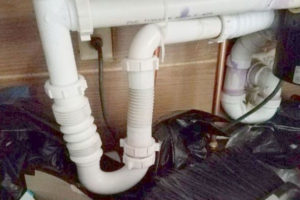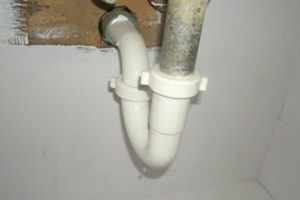Poopy smells usually come from the toilet.
So what exactly is that poopy smell coming from your sink or shower drain?
Sludge Begone

Most of the time, stink is from sludge on the stopper, drain cover, or top of the drain pipe. If you pull out the stopper and see a tangled hair mess, sludge is your problem. If you run warm water and smell sewer, sludge is your problem. Making sludge begone is pretty easy – grab a hair drain clog remover plastic strip at your local hardware store or search and buy online. It should be obvious but make sure to throw the sludge into the trash (not back into the drain). You can also flush the drain with boiling water.
Check Your DWV
DWV is a sexy acronym for a very un-sexy topic: Drain, Waste, and Vent system. Your DWV system helps to remove sewage from your house and regulates air pressure in the waste-system pipes to aid free flow. Waste is produced at toilets, sinks, and showers, and exits the fixtures through a “trap,” a dipped section of pipe that always contains water. If you look under one of your sinks, you’ll see a U-shaped dipped section which includes a trap which holds water in the pipe. The water effectively blocks the movement of sewer gas from the sewer or septic system up to the sink and into the room.
Poopy Smells and Gurgles

As if poopy smells weren’t bad enough, sometimes your drain gurgles and burps. This occurs when your sinks or drains include non-vented S-traps, which are no longer permitted in new construction, but which are prevalent in older homes and in “handyman” repairs. The water that’s supposed to be in the S-traps may be siphoned out when drain water rushes through the pipes. It creates negative pressure or a vacuum behind it, sucking the trap dry. Without water to block air, sewage gas can flow back up the drain and into the room. If one of your sinks or drains has an S-trap and there’s a stench, consider retaining a plumber to install the correct configuration. If your home is vacant while you’re away on an extended vacation, or it’s a seasonal property, the traps may dry out naturally via evaporation. Just run a bit of water down the drain to refill the trap.
P-trap Problems

P-traps usually work well but if you’re not careful, you can damage a trap if you try to remove hairballs and sludge too aggressively. Don’t use a repurposed wire clothes hanger. Avoid environmentally harsh acids and drain cleaners. Drain augers that attach to a drill can damage older pipes. Try covering up the sink or tub’s overflow opening and using a simple plunger. A rapid up-and-down plunging movement can clear many clogs.
And you’ll be back to free-flowing, sweet-smelling drains in no time!
